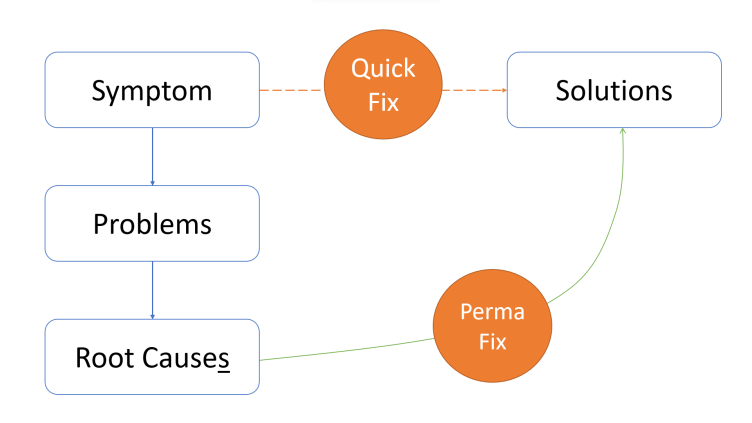
Anatomy of Creative Problem Solving
The most enduring skill in the world is 'problem solving'.
It remained relevant in the dark ages and keeps us busy in the computer age and would be of bearing in the inter-galactic space age. While the tools of problem solving might augment our skills, but the core skill would be lasting. So, if you wish to future proof your career, be an expert problem solver. What characterizes a 'creative' problem solving' as against problem solving in general is the origin of a novel solution.
Our present models of problem solving are highly reliant on common sense, gut feel and mostly (mis)guided by our past experiences. Alas, creative problem solving is marked with less than desirable outcome, where the effort goes in 'solution selection' rather than 'solution creation'. And, over time, you realize that you have reduced your intellect to just about pattern recognition, something machines are beating us at. So, how do we augment our problem solving skills? In this piece, I offer what goes behind expert problem solving and how you can hone your creative skills, at workplace and beyond.

Understand that Every Problem is a Symptom
Imagine you walk up to a doctor, and she asks you, "so, what's your problem?", and you utter, "I have a serious headache, stomach cramps. I am unable to sleep at night, and have lost my appetite." Essentially, what are you describing-- your problem or symptoms? These are certainly the symptoms, for you have not the faintest of the inkling as to what's ailing you. And yet you have the audacity to claim that you understand somebody else's problem! What you essentially know of are the symptoms and a good doctor helps you navigate through the maze of symptoms to unearth the problems and thereon the the solutions.
Remember, what ever you think of is a problem is nothing more than a symptom. And by confusing symptom with the real problem you are short-circuiting the entire discovery process. You won't just be able to solve anything significant, but might end up worsening the situation. So, call every problem as a symptom and this very mindset shift changes your entire approach.
Think of it. If I call attrition as a problem versus a symptom, what changes about your attitude towards it? If you call it a problem, then you jump to solving it, whereas, if you understand it to be a mere symptom of something more sinister, you would then investigate it further, and hopefully arrive at a better understanding of possible avenues.
Quick Fix Should be an Option, not a Default
If you mistake the symptom for a problem, then you most likely would assault it, and that too with solutions that have worked in past. In the case of attrition as a symptom, you would regress to measures like pay hikes, promotions, bonuses, recognitions, visibility, or in certain cases, threat. But these are temporary fixes, for the underlying problem remains unaddressed. And you would soon be in a worst off situation, stripped of your usual ammunitions. Let's call this approach as the 'Quick Fix'.
I am not dismissing the importance of quick fix, as there are certain situations that don't warrant a deeper treatment. However, you can't live by Quick Fix as your default mode. You must select otherwise, and for that you must know a more robust approach. The one that offers a permanent fix.
When to use the Quick Fix? There are two conditions I would offer: Low frequency and Low Impact. If you encounter a one-off phenomenon, which if not delved deeper into won't result in massive impact, you must conserve your cognitive capacities and resort to Quick Fix. That's close to what the Nobel Laureate Daniel Kahneman would call the System-1 thinking. But he also notes that the System-1 often results in predictable errors of judgement, and you don't even realize how wrong you are, owing to the overconfidence on the ensuing solution (since it has worked in past). However, there's a better approach that could offer a permanent kill. But before that, we must realize that every problem is symptomatic of multiple root causes.
There is Never 'a' Root Cause
We have got to believe that every problem has 'a' root cause, or 'the' root cause, which, if addressed, would yield the solution. But it's never the case that one lacuna alone rocks the system. It's multitude of root causes that act in concert manifesting the problems and the symptoms thereof. Again, going back to the case of employee turnover. What could be the root causes across a cross-section of employees? Poor skill-role fitment, un-inspiring bosses or colleagues, toxic work environment, limited growth, no work-life-family balance, locational challenges, and the ilk. Which one would you attack? And even if you solve one you think is the root cause, other's may still manifest in yet other uglier symptoms and you get into an endless pursuit.
The remedy is to understand that there's always a plurality of root causes and not one single devil. You must continue your root causes analysis and elicit as many core issues as possible and only then prioritize the ones that have the maximum bearing. Once you get to understand and ascertain the root causes and get to solving those, you get into a 'Perma Fix' (short for Permanent Fix) dialogue. This would, most likely, offer enduring fixes. But, remember, it takes time as you need to chose which problem is worth solving the Perma Fix way. Here again the heuristics is: High Frequency and High Impact problems. The ones you can't live without addressing for long.
In general, still about 70% of your problems would be worth the Quick Fix route, and rest 30% must take the Perma Fix, the long drawn approach. The Quick Fix, as you would realize is about 'Solution Selection', whereas 'Perma Fix' is to do with 'Solution Creation'. Finally, one core realization.
Solving a Problem is not Same as Creating a Solution
We often delude ourselves premature that we have solved a problem, whereas what we have achieved is to douse the symptom, for the time being. Think of how relieved you feel to pacify a crying child with a candy, not realizing that there's something hidden, more fundamental at play. It's a common misbelief that while you solve a problem you have created a solution. No, you have just solved 'a' problem, and not 'the' problem.
A Perma Fix is about solving a problem in a manner that it never ever resurfaces again. Let's suppose a table is shaking. One Quick Fix is to tuck a folded piece of paper under one of it's legs, and the problem is solved. But you haven't yet created any solution. Think of what happens when you roll your sleeves and get into the understanding of why the table is shaking? Is it to do with uneven floor? Or that one of the legs has withered away? Or a bush is missing? Once you understand the set of root causes, you design adjustable bushes that go into every table, such that a table never ever shakes again. That's creating a solution.
Creating a solution calls for patience, skills, endurance, insights, and above all, focus. So, best wishes in sharpening your problem solving skills. Hope this is useful.
Trending
-
1 Jocko Willink's Inspirational Life & Net Worth
Aaqil Ashraf -
2 How Art Shapes Culture and Reflects Human Experience
Luke Fitzpatrick -
3 Meet Felix Williams and Maria Arthuer: The Parents of World Class Winger Nico Williams
Felix Yim -
4 Kai Cenat's Dad and the Enduring Public Interest
Aaqil Ashraf -
5 London Tube Stations Closed as Workers Stage Strikes
Mihir Gadhvi





Comments